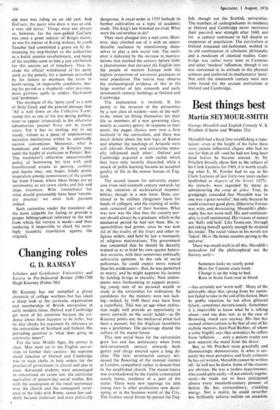Changing roles
G. D. RAMSAY
Scholars and Gentlemen: Universities and Society in Pre-Industrial Britain 1500-1700 Hugh Kearney (Faber 50s) Dr Kearney has not compiled a glossy chronicle of college worthies but has taken a sharp look at the curricula, organisation and membership of British universities in early modern times. Oxford and Cambridge get most of his attention because the evi- dence about them happens to be fuller, but he also checks his argument by reference to the universities of Scotland and Ireland. His pervading question is 'what does going to university mean?'
For the later Middle Ages, the answer is clear. Men went up to the English univer- sities to further their careers: the supreme social function of Oxford and Cambridge was to train clerks in holy orders for the practice of government in church and also in state. Advanced students were encouraged to concentrate on canon law, the curricular equivalent of present-day social studies. But with the assumption of the royal supremacy over the church and the consequent sever- ance of the links with Rome, canon law sud- denly became irrelevant and even politically dangerous. A royal order in 1535 forbade its further cultivation as a topic of academic study. The king's law brooked no rival. What were the universities to do?
They were plunged into a real crisis. How- ever, they climbed out of it with an unpre- dictable resilience by transforming them- selves to play a new social role. The resili- ence is indicated by the increase in matricu- lations that marked the century before 1640, a phenomenon that elevated the English into the people of western Europe with the highest proportion of university graduates to total population. The tourist may observe the archaeological evidence of this in the large number of late sixteenth and early seventeenth century buildings at Oxford and Cambridge.
The explanation is twofold. It lies partly in the invasion of the universities by a new class of student—sons of the well- to-do, intent on fitting themselves for their life as members of a new governing class, mostly as country gentry. In response to their needs, the pagan classics now won a firm foothold in the curriculum, and there was much debate about the new logic of Ramus and whether the teachings of Aristotle were still relevant. Gentry and universities mutu- ally influenced each other: Oxford and Cambridge acquired a snob cachet which they have only recently discarded, while a smack of polite learning became an accepted quality of life in the manor houses of Eng- land.
The second reason for university expan- sion from mid-sixteenth century onwards lay in the retention of ecclesiastical responsi- bilities, though in a new form. Dons con- tinued to be celibate clergymen (save for heads of colleges), and the training of ordin- ands remained part of their business. What was new was the idea that the country par- son should always be a graduate, which in the mediaeval period he had not been. His re- sponsibilities had grown, since he was now rid of the rivalry of the friars and other re- ligious orders, and held by law a monopoly of religious ministrations. The government was concerned that he should be decently trained so as to hold his own against hetero- dox sectaries, with their sometimes politically subversive opinions. In this role of social policeman, he could expect more reward than his predecessors: thus, he was permitted to marry, and he might augment his income by holding livings in plurality. New endow- ments were forthcoming to support promis- ing young men of no personal wealth to study at the universities for ordination. So candidates for the ministry were not lack- ing—indeed, by 1640 there may have been a superfluity. This was an age when ordina- tion might well provide an opportunity to move upwards on the social ladder—as Dr Kearney points out, the mediaeval priest had been a peasant, but the Anglican incumbent was a gentleman. The parsonage shared the culture of the manor-house.
This new social basis for the universities grew less and less satisfactory when from mid-seventeenth century onwards both gentry and clergy entered upon a long de- cline. The later seventeenth century wit- nessed the flowering of the monied interest at London, sympathetic rather to dissent than to the established church. The manor-house was overshadowed by the freshly-constructed stately home, residence of a peer of the realm. There were new openings for able young men in other professions now devel- oping, or in the business world of the City. The liveliest social forces by-passed the Eng-
lish, though not the Scottish, universities. The numbers of undergraduates in residence at Oxford and Cambridge never recovered their pre-civil war strength after 1660, and for a century continued to fall despite an expansion of population. The curriculum at Oxford remained old-fashioned, wedded to its old combination of scholastic philosophy and a modicum of classical studies. Cam- bridge was rather more open to Cartesian and other 'modern' influences, though it too was restrained in its attitude to the physical sciences and preferred its mathematics 'pure'. Not until the nineteenth century were new roles found for the ancient institutions at Oxford and Cambridge.






























 Previous page
Previous page